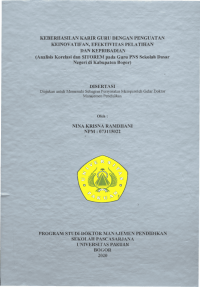Disertasi MP
Keberhasilan Karir Guru dengan Penguatan Keinovatifan, Efektivitas Pelatihan dan Kepribadian: analisis korelasi dan SITOREM pada guru PNS SDN di Kabupaten Bogor
This study aims to determine the relationship between independent variables: innovation, effectiveness of training and personality both individually and together with the dependent variable, namely teacher career success. The selected sample was 367 people in proportional random sampling using the Krejcie table. This study uses a survey method with a correlational approach followed by Sitorem's analysis. The results of this study concluded that: (1) there was a positive relationship between innovation and teacher career success with a regression equation 79 ,0 ,87Yˆ 1X39 with R = 16%, (2) there was a positive relationship between training effectiveness with teacher career success with a regression equation 37,0,82Yˆ 2X39 with R = 15%, ( 3) there is a positive relationship between personality and teacher career success with a regression equation 58,0,89Yˆ3X36 with R = 14%, (4) there is a positive relationship between innovation and effectiveness of training together with teacher career success with a regression equation Ŷ = 95.45 + 0, 84X1 - 0.46X2 with R = 16%, (5) there is apositive relationship between innovation and personality together with teacher career success with the regression equation Ŷ = 88.22 + 0.42X1 - 0.04X3 with R = 16% , (6) there is a positive relationship between training effectiveness and personality together with teacher career success with the regression equation Ŷ = 82.372 + 0.388X2 + 0.002X3 with R = 15%, (7) there is a positive relationship between innovation, training effectiveness and personality together with teacher career success with a regression equation Ŷ = 95.440 + 0.836X1 - 0.462X2 -0.002X3 with R = 16% and (8) The results of the analysis Sitorem shows that based on priority order of improvement, it can be proposed for improvement recommendations, namely: 1) management innovation, 2) service innovation, 3) emotional stability, 4) analysis of training needs, 5) openness to experience, 6) improvement of training, 7) process innovation, 8) training design, 9) training implementation, 10) training evaluation, 11) product innovation, 12) hospitality, 13) awareness
Ketersediaan
Informasi Detail
- Judul Seri
-
-
- No. Panggil
-
8/RAM/D-MP/2020
- Penerbit
- Bogor : SPs. Universitas Pakuan., 2020
- Deskripsi Fisik
-
iii, 602 hlm. : ilus. ; 28 cm.
- Bahasa
-
Indonesia
- ISBN/ISSN
-
-
- Klasifikasi
-
8/RAM/D-MP/2020
- Tipe Isi
-
-
- Tipe Media
-
-
- Tipe Pembawa
-
-
- Edisi
-
-
- Subjek
- Info Detail Spesifik
-
-
- Pernyataan Tanggungjawab
-
Prof. Dr. H. Thamrin Abdullah, MM., M.Pd. dan Dr. Hj. Rita Retnowati, M.S.
Versi lain/terkait
Tidak tersedia versi lain
Lampiran Berkas
Komentar
Anda harus masuk sebelum memberikan komentar

 Karya Umum
Karya Umum  Filsafat
Filsafat  Agama
Agama  Ilmu-ilmu Sosial
Ilmu-ilmu Sosial  Bahasa
Bahasa  Ilmu-ilmu Murni
Ilmu-ilmu Murni  Ilmu-ilmu Terapan
Ilmu-ilmu Terapan  Kesenian, Hiburan, dan Olahraga
Kesenian, Hiburan, dan Olahraga  Kesusastraan
Kesusastraan  Geografi dan Sejarah
Geografi dan Sejarah